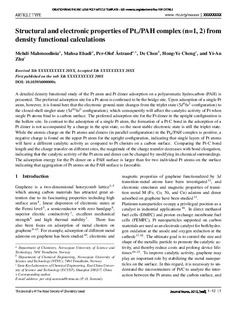| dc.contributor.author | Mahmoodinia, Mehdi | |
| dc.contributor.author | Ebadi, Mahsa | |
| dc.contributor.author | Åstrand, Per-Olof | |
| dc.contributor.author | Chen, De | |
| dc.contributor.author | Cheng, Hong-ye | |
| dc.contributor.author | Zhu, Yi-An | |
| dc.date.accessioned | 2017-10-27T10:52:16Z | |
| dc.date.available | 2017-10-27T10:52:16Z | |
| dc.date.created | 2014-08-06T17:16:54Z | |
| dc.date.issued | 2014 | |
| dc.identifier.citation | Physical Chemistry, Chemical Physics - PCCP. 2014, 16 (34), 18586-18595. | nb_NO |
| dc.identifier.issn | 1463-9076 | |
| dc.identifier.uri | http://hdl.handle.net/11250/2462563 | |
| dc.description.abstract | A detailed density functional study of the Pt atom and the Pt dimer adsorption on a polyaromatic hydrocarbon (PAH) is presented. The preferred adsorption site for a Pt atom is confirmed to be the bridge site. Upon adsorption of a single Pt atom, however, it is found here that the electronic ground state changes from the triplet state (5d96s1 configuration) to the closed-shell singlet state (5d106s0 configuration), which consequently will affect the catalytic activity of Pt when single Pt atoms bind to a carbon surface. The preferred adsorption site for the Pt dimer in the upright configuration is the hollow site. In contrast to the adsorption of a single Pt atom, the formation of a Pt–C bond in the adsorption of a Pt dimer is not accompanied by a change in the spin state, so the most stable electronic state is still the triplet state. While the atomic charge on the Pt atoms and dimers (in parallel configuration) in the Ptn–PAH complex is positive, a negative charge is found on the upper Pt atom for the upright configuration, indicating that single layers of Pt atoms will have a different catalytic activity as compared to Pt clusters on a carbon surface. Comparing the Pt–C bond length and the charge transfer on different sites, the magnitude of the charge transfer decreases with bond elongation, indicating that the catalytic activity of the Pt atom and dimer can be changed by modifying its chemical surroundings. The adsorption energy for the Pt dimer on a PAH surface is larger than that for two individual Pt atoms on the surface indicating that aggregation of Pt atoms on the PAH surface is favorable. | nb_NO |
| dc.language.iso | eng | nb_NO |
| dc.publisher | Royal Society of Chemistry | nb_NO |
| dc.title | Structural and electronic properties of the Ptn–PAH complex (n = 1, 2) from density functional calculations | nb_NO |
| dc.type | Journal article | nb_NO |
| dc.description.version | submittedVersion | nb_NO |
| dc.source.pagenumber | 18586-18595 | nb_NO |
| dc.source.volume | 16 | nb_NO |
| dc.source.journal | Physical Chemistry, Chemical Physics - PCCP | nb_NO |
| dc.source.issue | 34 | nb_NO |
| dc.identifier.doi | 10.1039/c4cp02488e | |
| dc.identifier.cristin | 1145588 | |
| dc.relation.project | Norges forskningsråd: 209337 | nb_NO |
| dc.relation.project | Notur/NorStore: NN2920K | nb_NO |
| dc.description.localcode | © The Royal Society of Chemistry 2014. This is the authors manuscript to the article. | nb_NO |
| cristin.unitcode | 194,66,25,0 | |
| cristin.unitcode | 194,66,30,0 | |
| cristin.unitname | Institutt for kjemi | |
| cristin.unitname | Institutt for kjemisk prosessteknologi | |
| cristin.ispublished | true | |
| cristin.fulltext | preprint | |
| cristin.qualitycode | 2 | |
